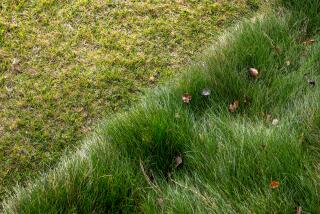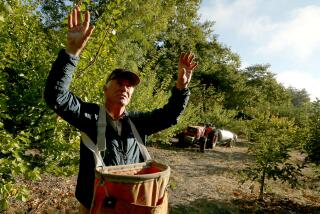Can scientists engineer drought-tolerant plants?
As the California drought enters its fourth year, scientists are trying to genetically engineer plants that survive on less water.
After adding a new piece of genetic code to their DNA, tomatoes and other plants were able to hold on to more water and survive for as many as 12 days without irrigation.
The tactic, described in the journal Nature, seeks to control how much water a plant loses through the small pores on its leaves known as stomata.
Stomata, as you may remember from biology class, let carbon dioxide in and oxygen out. The size of the opening is regulated by two guard cells that can inflate like little tires.
The stomata are usually open during the day to allow the plant to capture carbon dioxide and produce energy. And because the air around the plant is usually drier than the inside of the leaf, water inevitably moves out through the opening – a process called transpiration.
When plants get stressed out from drought, they produce a hormone called abscisic acid, or ABA, that tells the guard cells to keep the stomata closed. That, in turn, keeps the plant from losing water.
Sean Cutler, a plant cell biologist at UC Riverside, said simply spraying plants with ABA to help them hold on to their water is not a feasible strategy. ABA is expensive to make, sensitive to light and quickly gets inactivated inside plants.
“It’s not practical for use for agriculture for a lot of reasons,” he said.
Another possibility is to create a chemical that mimics ABA. Some scientists are working on it, but this option has hurdles too – the chemical might be toxic, or last too long in the environment, or affect marine life. It is also extremely expensive and time-consuming to bring a new chemical to market.
So Cutler’s group took a different approach. They started with an existing agrochemical called mandipropamid that is currently used to control blight on a variety of fruit and vegetable crops. Then they genetically engineered plants to respond to mandipropamid – call it “mandi” for short – as if it were ABA.
In the experiments described in the paper, the researchers left mandi as it is and altered the protein receptors inside the plant that usually bind to ABA so that they would bind to the mandi instead. To do that, they inserted a new piece of genetic code into the plant’s DNA so it would build a protein receptor with a slightly different shape.
The researchers put the new code in two types of plants – tomatoes and Arabidopsis. In both cases, the plants closed their stomata in response to being sprayed with mandi. That made them more drought-tolerant than their unaltered counterparts. Even after going 12 days with no water, the altered plants were able to recover after being re-watered, while the non-altered plants did not.
It is the first time that anyone has used synthetic biology to reprogram a plant response to a specific chemical, Cutler said.
He added that there are some limitations with this technique, however. It only works on plants that have had the new gene added. Also, while closing the stomata keeps plants from losing water, it also keeps them from growing.
“The response we get is like hitting a pause button,” he said. “The downside is you are also pausing growth.”
Cutler said the work now needs to be tested in real-world crops. His team will also investigate other beneficial responses in plants that could be controlled chemically. Eventually, he hopes these techniques can help address future water shortage issues.
“The water problem does not seem to be going away, so our job is to come up with as many ideas as possible,” he said.
Science rules! Follow me @DeborahNetburn and “like” Los Angeles Times Science & Health on Facebook.







